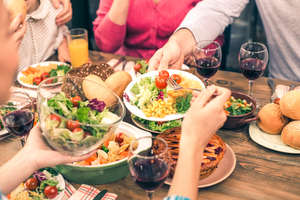Did you know that men have a higher prevalence of prediabetes than women? Did you also know that only 11% of men are aware they have it? Prediabetes, commonly referred to as borderline diabetes or impaired glucose tolerance, is a condition in which blood sugar levels are higher than normal, but not yet high enough for a clinical diagnosis of type 2 diabetes. Why are signs of diabetes in men so important? If left uncontrolled, prediabetes often leads to type 2 diabetes within five years. It's a ripple effect. Men are more likely to have diabetes but are less likely to be diagnosed which translates into higher complication development because men are not properly managing the undiagnosed disease.
What Are the Risk Factors of Prediabetes for Men?
There are usually no symptoms of prediabetes, which makes identifying risk factors one of the best defenses against developing the disease. Men who can identify with one or more of the following risk factors are at greater risk for prediabetes or insulin resistance:
- Overweight
- Age 45 or older
- Having a parent or sibling with diabetes
- African American, Alaska Native, American Indian, Asian American, Hispanic/Latino, Native Hawaiian, or Pacific Islander American ethnicity
- A sedentary lifestyle
- High blood pressure
- Abnormal cholesterol levels
While these risk factors can apply to both sexes, a prediabetes study has found that certain risk factors including obesity, high blood pressure, and low HDL-cholesterol levels, can be stronger for men than women. The study also identified excessive alcohol consumption, as well as abdominal obesity, as risk factors for prediabetes in men.
How Can Men Manage Prediabetes at Different Ages?
Recognizing prediabetes early in its onset can prevent or delay onset of type 2 diabetes. Since we now know that prediabetes can develop early in life, men should consider the following ways to keep prediabetes at bay during each stage of life:
During Puberty (10-19):
The best way to offset prediabetes throughout adolescence is to utilize a primary care provider. This includes undergoing regular health screenings and exams to detect any health problems, especially medical conditions that first become apparent (or worsen) at puberty. The connection to diabetes? According to a study, boys who enter puberty at an earlier age are more likely to develop type 2 diabetes as adults. Males generally begin puberty around age 11 and complete puberty around age 17. Hormonal changes that occur during puberty, including the release of testosterone and cortisol, can contribute to insulin resistance.
Additionally, keep in mind that people with a family history of diabetes have an increased risk of developing prediabetes. So, it's important to take preventative measures early on. Be sure to discuss your family's medical history with your primary care doctor so they can establish early steps you can take to help prevent prediabetes from evolving further. Regardless if you are at an increased risk, there are plenty of things you can do at an early age to help prevent or delay a diagnosis including eating healthier, being physically active, and maintaining a healthy weight. If you establish these healthy habits early on, you are more likely to take these methods with you through adulthood.
In A Man's 20s:
The Research Society on Alcoholism states that binge drinking among men tends to increase from age 18 through the early 20s. Essentially, men are more likely to drink higher amounts of alcohol more sporadically in this stage of life. Why is this important in the scope of managing prediabetes? Binge drinking eliminates a man's ability to understand how his alcohol consumption is impacting his prediabetes diagnosis. This is a risk considering alcohol can directly affect diabetes through a number of ways:
- Alcohol tends to have a lot of calories which can complicate the ability to lose excess weight
- Alcohol contains carbohydrates which can cause blood glucose levels to rise
- Alcohol stimulates your appetite which may cause you to overeat (making it harder to control your weight and blood sugar levels)
- Alcohol may increase your blood pressure
Essentially alcohol consumption has the potential to impact every area of prediabetes management. This means that in order to effectively manage prediabetes, men need to keep best practices top of mind. For instance:
- Men with prediabetes should not drink more than 2 alcoholic beverages per day
- Only drink alcohol when consumed with food
- Drink slowly
- Avoid drinks with high amounts of sugar
- Mix liquor with water, club soda, or diet soft drinks
Men in their 20s can effectively manage prediabetes by consuming alcohol responsibly. Know your limits, know your blood sugar levels, and always consider whether or not the consumption of alcohol is more likely to help or hurt your management practices.
In A Man's 30s and Beyond:
As men get older, they are more prone to developing high cholesterol and hypertension. Why is this significant? Both high cholesterol and high blood pressure can make the effects of prediabetes even more prominent and even expedite a type 2 diagnosis. Doctors recommend that men begin cholesterol screenings between the ages of 20 and 35 to help prevent high cholesterol as well as prediabetes. The urgency of these checks only rises with age. Men in their 20s are recommended to get their cholesterol levels tested once every 5 years. As men age the frequency increases to ensure that your levels are in a healthy range. Additionally, the incidence of hypertension is also greater among adult males. Not to mention, people with high blood pressure have a 50% increased risk of developing type 2 diabetes. Since hypertension is a high-risk factor for prediabetes, it's important for men to have blood pressure screenings at least once a year beginning at age 40.
Although your chances of developing high cholesterol and hypertension increase as you get older, making healthier food choices is a great way to combat both of these conditions while also reversing the effects of prediabetes. Start incorporating foods like whole grains, fruits, vegetables, and healthier cooking oils such as olive oil or avocado oil into your meals for a well-balanced diet. This will help you manage your cholesterol and blood pressure levels, which in turn can help manage your blood sugar level. The earlier you begin to make healthy lifestyle choices, the more likely you are to carry these best practices through your later adult life.











.webp)





-images-0.jpg)

